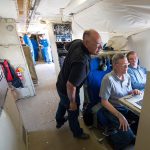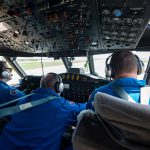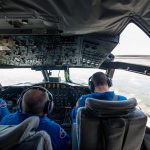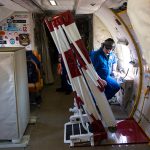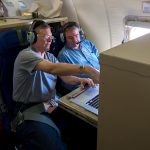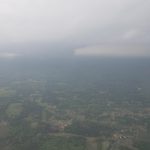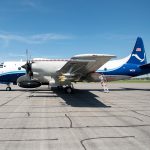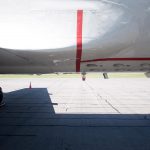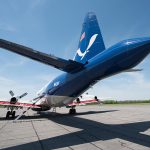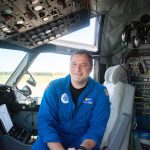Chasing tornadoes and hurricanes with an airplane reveals an unprecedented view of their reach, threat and power. But it’s a rocky ride. Medill News Service reporter and Comer Scholar Morgan Levey hopped a front row seat in the cockpit of the P-3 “hurricane hunter” as an embedded reporter with NOAA’s National Severe Storms Laboratory. She continues to explore innovations at the cutting edge of weather forecasting and delivering on crucial extra minutes of warning to communities. Follow her blog posts here.
A ride in the P-3: Chasing tornadoes from the air
By Morgan Levey
Friday, April 13, Huntsville, Alabama.
“I got the feeling…I got the feeling,” sings one of three P-3 pilots as mechanics outside our plane conduct a final check before we can take off.
I’m buckled into a makeshift seat in the cockpit of NOAA’s P-3 “hurricane hunter” behind Commander Kibbey and I can hear the preflight chat between the pilots and ground control through my headphones. Everyone’s feeling good about getting the green light for the flight. I’m just trying to document the moment and not anticipate the nine hours of airborne surprises ahead.
They gave me a seat in the cockpit for takeoff and I watch as Commander Kibbey runs down a preflight checklist with the two pilots next to him. A small, stuffed Kermit keychain (the P-3’s namesake) hangs over the dashboard as they press buttons, flip switches and keep an eye on endless dials. My foot accidentally kicks a cord out of a jack. In my panic, I look around only to realize that a switch marked “Oxygen in cabin” is right above my head. I’m the only one who appears worried about all this though and I sit still, careful not to bump anything else.
1:48 p.m. Takeoff
Moments later — and almost without warning — we’re heading down the runway and pulling into sunny skies. The view ahead of me is beautiful and I realize I’m looking through the windshield after a lifetime of looking out the window of the backseat. The plane feels small from up here and you could easily forget about the mass of wings, propellers and engines behind us. It feels like we’re in a Smart Car when we’re really navigating a semi truck.
We reach our 2,500-foot, low-altitude elevation within minutes and I can see fields of green very clearly below. The plan for the flight is first to do a fly-over survey of a previously storm-damaged area near Decatur, Alabama, and then to head to a squall line of storms located near Shreveport, Louisiana. We were told during our preflight brief the storm is moving north-northeast at 30 knots.
The seatbelt sign is off and I move back to my seat in C3X next to Ian Sears. He’s the backup flight director for this flight, second in command to Jessica Williams, who’s sitting at a console ahead of us watching several monitors of radar readings that show exactly where the plane is in relation to the weather.
The flight director acts as the intermediary between the scientists, in this case, principal investigator and meteorologist Conrad Ziegler and radar scientist Kim Elmore, and the pilots/ flight commander. The scientists observe weather — thunderstorms and supercells — they’d like to fly near and tell the flight director. She then approves or denies the scientists’ requests, based on her knowledge of the plane’s capabilities and safety protocols.
The scientists’ goal is to fly parallel to a line of storms, getting as close as possible. The closest the plane can safely get to a storm is five miles, but isolated storms can pop up in front of the line, prohibiting the plane from getting close to a squall line. Meanwhile, the second flight director, Sears in this case, watches the greater surrounding area for other storms that may arise while the scientists and first flight director are focused on the plane’s immediate surroundings.
Data technician Mike Mascaro set up the computer at my seat so I can now toggle between a camera on the nose of the plane and a map of the flight path. Frankly, though, I feel terrible. We are nowhere near the storms and the ride is already hitting stomach-churning turbulence. At only 2,500 feet we’re in the “boundary layer,” where convection from the earth’s surface causes disturbance in the air and makes the flight bumpy. Just under 30 minutes into the flight and I get sick.
Shortly after, they take the plane up to a higher elevation. The visibility is too low to get a clear reading on the ground damage and so we get clearance to take the plane up to 10,000 feet, above clouds where the ride is smoother. We’ll also get to the storms faster.
The atmosphere in the plane is casual at this point in the ride. Crew members are napping at the back (how, I have no idea) or hanging out in the small dining area where there’s a booth-style table. People are chatting…and eating. Sears tells me that his strategy for avoiding motion sickness is just to eat throughout the entire flight. He munches on a roast beef sub as he tells me this. I notice on Sears’ computer that he told the crew about my sickness via their internal chat and people keep coming by with helpful suggestions or just giving me the thumbs up.
3:28 p.m. Shreveport squall line
After almost two hours of flying, we arrive at our first squall line near Shreveport, Louisiana. Through my headphones, I can hear the conversation between Ziegler and Williams. After a few laps of the storm, I realize that their conversation follows a formula. As we fly along the storm line, Williams asks Ziegler to tell her when he’d like to turn — “Five miles, 10 miles?” “Let’s turn in five,” he says. A few minutes pass in silence and then Williams says, “Tell us when.” And Ziegler replies, “The tail Doppler radar (or TDR) is still painting the storm.” Or “Ok, turn now,” he says.
Williams instructs the pilot to turn 90 degrees away from the storm and then 270 degrees back towards the storm. This way the plane is able to fly the whole squall line without turning into it. And then they proceed to have the same exchange over again, repeating this whole sequence of events until the storm dies out and there’s nothing left to “paint” with the radar.
This first cell is pretty anticlimactic — not at all what I expected. I thought that once we arrived at the storms the fasten seatbelt sign would turn on, we’d all strap our seatbelts over our shoulders and the turbulence would increase. But it’s smooth sailing and the seatbelt sign isn’t On. Sears isn’t even in his seat. Outside, the sky is still pretty light and storm clouds are only noticeable when your side of the plane is passing the storm cell. The hope is that this cell could produce a mesocyclone, a tornado, but it doesn’t.
4:09 p.m. Move south to the second cell
Around 4 p.m. the scientists request a move to another squall line south of Shreveport and it appears to have pop up cells and strong updrafts — the making of a tornado. At 4:11 p.m., just after we begin lapping the second cell, the fasten seatbelt sign goes on for the first time of the flight. I prep for some heavy turbulence, but Sears tells me I only need my lap belt, the shoulder straps are overkill. Then the sign gets turned off after two minutes.
The mood on the plane is still pretty relaxed and it’s clear that the weather isn’t panning out as expected. This storm is not as severe as forecasted, but despite the mild weather we still repeat the same dance we did at the last storm line – sweeps from one end of the storm to the other and big arcing turns at the end. I understand why the scientists keep saying we’re “painting” the storm with radar, our whole movement is like one long brushstroke.
4:53 p.m. Move to third cell
“Not the storm we were expecting as of yet,” says Ziegler over the headphones. The weather that was forecasted for the Shreveport area either hasn’t arrived yet or is not coming. Williams walks back to Ziegler’s seat and they chat about where to next. They decide to move us to a cell northeast of where we currently are. On the radar map it appears that the most severe weather is northwest of us, but out of reach since it lays beyond a line of storms we can’t fly through.
Near this third cell, I start to see large cracks of lightning off my side of the plane. According to Ziegler, the tops of the updrafts are getting to 14 km, meaning conditions are right for a mesocyclone. Over the headphones, I hear Ziegler say that it looks like the storm is turning into a super cell.
Williams charges up the dance. Instead of two turns — a 90 degree turn away from the storm and a 270 degree turn back towards the storm — she decides we can do a quick 180-degree turn, which will maximize our time along the storm. This entails putting the plane’s wing down at a 30-degree angle and spinning 180 degrees. Since the plane is not pressurized this means we get thrust down into our seats and then pop back up when we’re righted. My stomach does not approve of the acrobatics and soon enough I’m sick for the second time.
Thankfully, I have multiple vomit bags with me at my seat. At the back of the plane is a dispenser of them and a couple people told me to grab at least two before we took off. These bags are different than the ones found on commercial flights, instead of a flat, wax-line paper bag, they are plastic with a hard plastic circle around the opening. No fumbling to fully open on this ride, passengers of the P-3 need quick, easy access.
5:33 p.m. The big one
By now, the third cell has petered out and the scientists and Williams decide to head toward a squall line southwest of us, on the south side of Shreveport. I work up the energy to leave my seat and go speak with Ziegler about what’s next. So far the weather has not been cooperating and I can hear the disappointment in his voice as he keeps navigating us from cell to cell.
After the flight, he tells me that it’s a hard part of the job — making the call on which cells to follow. Operating the P-3 is not cheap and a lot of people power and energy goes into the missions. No one on the flight, including the scientists, is hoping for deadly, damaging weather. But if it’s going to happen anyway, they want to be the right position, poised to map it with radar so they can get one step closer to learning why tornadoes occur and ways to increase warning times for communities on the ground.
At 6:09 p.m. we begin lapping the fourth storm cell of our ride. Despite the roughly 30-minute break between storms and the 180-degree turns, I’m still not feeling great. While the fasten seatbelt sign has been off for most of the flight, I’ve been seatbound with my forehead pressed against the window watching the horizon. Torn between wanting to document this experience and feeling like I’m going to get sick every time I move, I get up to do an interview or take a photo every once in a while and then immediately return to the comfort of my window.
But even in my nausea stupor, I can tell that the mood on the plane has changed perceptibly with this storm. “Looks like we’ve picked a winner,” says Ziegler over the headphones. “Best mesocyclone of the day reported on the ground here,” he continues. Outside the window, there’s a large dark cloud with what appears to be rain underneath.
We lap the storm six times, moving along a northeast/ southwest path, making one of those soul-crushing 180-degree turns every four minutes or so.
6:33 p.m. Tornado!
And then: tornado sighting. Williams announces that a tornado on the ground is visible out the left side of the plane. Everyone is at the window instantly, even me. It’s hard to see, but the big dark cloud with rain has a grey spot extending down. The twister.
The atmosphere on the plane is electric. Even for a crew that flies through the eye-wall of hurricanes and has done eight flights chasing mesocyclones this season, actually seeing a tornado touch ground from the air is a rare experience.
According to the flight-event notes taken by scientist Kim Elmore, the tornado could still be seen four minutes later. And at 6:44 p.m. the crew sees a flash — the tornado takes out a transformer on the ground. Meanwhile, we’re still lapping the storm, collecting data as we go.
7:06 p.m. Second tornado
And then a second tornado is spotted. And quickly this one takes out another transformer and there’s a large flash. Everyone runs to the window again, except for me. This time I’m getting sick. Motion sickness can be so debilitating — even though I have a once-in-a-lifetime view of one of the most dramatic weather events, I just don’t care. All of my energy is focused on halting the nausea and feeling better. And that means I’m not moving from my seat.
But man, the crew is excited. Especially Ziegler and Williams. But having duties that entail keeping their eyes glued to monitors means they can’t get up and rush to the window. There’s brief talk of Ziegler switching seats so he can see, but he doesn’t mind. He’s committed to collecting the data.
“Shaping up to be one of the best data sets of VORTEX-SE,” says Ziegler over the intercom. After hours of disappointing weather, the fourth cell delivered. We spend the next hour and a half lapping this storm, still turning every four minutes or so.
8:32 p.m. Heading back to Huntsville
At 8:15 p.m. the storm transforms from a supercell into a bow echo. We spend about 15 more minutes lapping the storm before it dies out and the scientists call it a day. It’s music to my ears when I hear that we’re heading home — we can increase altitude and sail back to Huntsville.
By 9:30 p.m. we’re on the ground. Never in my life have I been so happy to be grounded, but as happy as I am the flight is over, I’m still glad I did it. The crew of the P-3 hurricane hunter could not have been more welcoming or informative and I’m so lucky to have witnessed them in action, particularly navigating the weather we saw.
We have a short debrief before the door is opened. A joke is made about me joining them in Florida for hurricane season — it’s well known that I got sick several times — and Commander Kibbey congratulates everyone on a job well done. And what a way to end the season — the project ended with a bang.
Descending the stairs, fresh air hits me in the face and I immediately begin to feel better. I contemplate sitting down on the tarmac but decide not to embarrass myself further and instead walk back in the dark to the Signature Flight Support building, thanking God that I don’t have to do that again.
Meeting the P-3 Hurricane Hunter
By Morgan Levey
Thursday, April 12, Huntsville, AL.
I arrived in Huntsville, Alabama and made my way over to the Signature Flight Support building, just 100 yards from the front entrance of the airport. I was meeting Mike Holmes, a flight director with NOAA’s P-3 “hurricane hunter” flight crew and my point of contact in Huntsville. Tomorrow, Friday the 13th, I will have a seat on the Lockheed WP-3D Orion aircraft while it takes its final flight of the season chasing thunderstorms and tornadoes for the VORTEX-SE project.
The P-3 flies through hurricanes but not thunderstorms and supercells. Instead, it flies parallel to a squall line, getting five to 10 miles away, as close as is deemed safe by the onboard flight director. Tomorrow’s flight is planned to be 9-hours long and will likely be “very turbulent.” Jessica Williams, the flight director, tells me that she got sick on their last mission, which does not bode well for me.
VORTEX-SE is a well-named acronym for Verification of the Origins of Rotation in Tornadoes Experiment-Southeast, a program focused on learning more about the formation of mesocyclones in the Southeastern U.S. This area of the country is thick with forests, a vastly different terrain to the Plains region, which is better known for its monstrous summer-time tornadoes. Here, the tornado season is earlier in the year — late January to April — and it sees a disproportionately large number of deadly twisters compared to the rest of the country.
It’s believed that the reason for this is both physical and sociological. Physical in that tornadoes in the Southeast form quickly, showing signs of formation just five to 10 minutes ahead of a cyclone, giving communities little warning time. Sociological in that tornadoes come earlier than perceived “peak season” of summer and they often occur at night when people are asleep. In 2012 a major tornado hit Mobile, Alabama on Christmas day.
VORTEX-SE brings together meteorologists, researchers and social scientists to study mesocyclones and the environmental factors that influence their formation, intensity and path specifically in this part of the country. The intent is to use the research to help storm prediction, improving warning times for communities, particularly people in rural areas who may not have immediate access to adequate shelter.
After meeting Mike I join a local group from NASA on a tour of the P-3 plane. Led by Flight Commander Justin Kibbey we walk 200 yards out to the plane on the tarmac. It’s a beautiful day in Huntsville, not a cloud in the sky, and Commander Kibbey is wearing ray bans and a royal blue flight suit. Tall, with a crew cut, he looks like he’s from another era and just stepped out of a movie.
The NOAA P-3 “hurricane hunter” aircraft is beautiful. As one of only two planes in the fleet, “Kermit” just got out of the shop. With new wings, engines and paint job, Kermit’s looks brand new from the outside. (I’m told Miss Piggy, the other flight in the fleet, is now getting revamped.)
After climbing a steep set of stairs into the plane’s backdoor emergency exit, I see that Kermit’s inside looks reminiscent of the year the plane was built — 1975. Orange upholstery on the seats, tinged walls and a canvas-covered ceiling, it feels like you’re stepping into a sepia-toned photograph. But it still houses racks of high-tech equipment — radar monitoring instruments, television monitors, computers and a cockpit that seems to have infinite buttons and switches.
Standing in the plane a line from the movie Almost Famous keeps playing over and over in my head, “I’m flying high over Tupelo, Mississippi with America’s hottest band and we’re all about to die.” It’s the beginning line in a fictitious Rolling Stone article written by the movie’s main character. It references a previous scene where he, along with the band he’s profiling, flies through a storm and the turbulence is so intense they all think they’re going to die.
How bad could the turbulence be on the P-3 flight tomorrow?
While I’m contemplating how sick and scared I’ll be on the flight, the NASA visitors are taking turns getting their photo taken while sitting in the cockpit. They’re like kids in a candy store and when they hear that I have a seat onboard tomorrow, their jealousy is palpable. A good reminder of how lucky I am to be hitching a ride.
We go outside and I take a few more photos of the plane. The aircraft is a four-engine turboprop, meaning its four propellers are exposed on the wings and can withstand large amounts of precipitation, which would drown the propellers of a commercial jet. It’s a Navy-style plane built using technology from the 1950s. I’ve been assured that it’s a beast in the air, built for flying in low elevations — 5,000-12,000 feet — with very sturdy wings. “It’s built like a truck,” Commander Kibbey says.
Standing under the wing I ask him about the silver instruments attached to the underside of the wings. He tells me they’re cloud particle probes used to measure the physics of a cloud. This plane is essentially a mobile-radar lab and it’s decked out with instruments to gain readings on wind speed, air moisture, precipitation, etc.
The oddest instruments are the red and white-striped poles attached to the nose and wing-tips, which are reminiscent of lances used in horse jousting. The poles on the wings measure wind speed, while the nose instrument is a C-band radar. Underneath the plane is a lower fuselage (LF) C-band research radar, and at the back of the plane are two tail Doppler radar (TDR).
After the tour, Commander Kibbey gives me my safety briefing for tomorrow’s flight. We stand on the plane as he goes down a list of emergency scenarios and points out safety equipment and exits. It’s odd, but as he lists the numerous things that could go wrong — a water landing (we weren’t scheduled to fly over water, but you never know he tells me), a fire onboard or an emergency landing — I just get increasingly excited. I’m completely confident in Commander Kibbey and his blue flight suit and am ready for the flight tomorrow.


